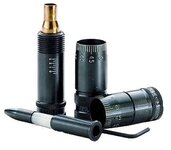The "Full length resizing?" and "Neck sizing only?" threads have been of interest to me, so I've got some questions for specific rifles.
At this point I've processed/loaded several thousand hand gun rounds in several calibers. I'm doin' it the old fashion way, single stage, with an RCBS Rock Chucker. I have a good feel for it and it's been enjoyable and rewarding. Now that I have a couple of old 100+ YO bolt rifles I will, at some point, be loading for them. First up will be the 1902 Swede Mauser. With handgun ammo you pretty much full length size all straight wall cases. Sizing makes the brass grow. Roll crimped brass needs to be uniform in length so it likely gets trimmed. Talking once or thrice fired range brass here. Never loaded new brass.
When it comes to the Swede. Will my once fired by me in my Swede, quality, brass need to be full length sized? If not, it means that the brass springs back enough that it will chamber, after re-loading, with only a neck size? The Swede head spaces on the shoulder(?), that would mean with the bolt face firmly against the case head when firing that a bump-back of the shoulder on sizing would not be needed?
Now, on to the SMLE BSA 1918 Enfield.....Same questions pretty much. Ammo is pretty cheap for that at $9.95/20 non-reloadable. So there's that to consider whether or not I'll ever reload for that. In some reading there have been people saying that chambers were very loose in these rifles to accommodate the filth and mud during WWI. That would indicate to me the .303 brass would likely need full length sizing after firing? where as the Swede head spaces on the shoulder it looks like the Enfield's head space on the RIM?
One other thing, after shooting that Enfield I noticed that there was some resistance when ejecting the empty brass after firing using German, MEN, surplus 1983 vintage rounds. A dependable source has told me it's good stuff. And no noticable resistance when chambering.
Eventually I plan on loading for the AR .223 also. But with the good Black Friday prices for ammo I've moved even farther into the future with that possibility.
This might seem a redundant thread, but putting it on paper, so to speak, seem to give me a better picture.
At this point I've processed/loaded several thousand hand gun rounds in several calibers. I'm doin' it the old fashion way, single stage, with an RCBS Rock Chucker. I have a good feel for it and it's been enjoyable and rewarding. Now that I have a couple of old 100+ YO bolt rifles I will, at some point, be loading for them. First up will be the 1902 Swede Mauser. With handgun ammo you pretty much full length size all straight wall cases. Sizing makes the brass grow. Roll crimped brass needs to be uniform in length so it likely gets trimmed. Talking once or thrice fired range brass here. Never loaded new brass.
When it comes to the Swede. Will my once fired by me in my Swede, quality, brass need to be full length sized? If not, it means that the brass springs back enough that it will chamber, after re-loading, with only a neck size? The Swede head spaces on the shoulder(?), that would mean with the bolt face firmly against the case head when firing that a bump-back of the shoulder on sizing would not be needed?
Now, on to the SMLE BSA 1918 Enfield.....Same questions pretty much. Ammo is pretty cheap for that at $9.95/20 non-reloadable. So there's that to consider whether or not I'll ever reload for that. In some reading there have been people saying that chambers were very loose in these rifles to accommodate the filth and mud during WWI. That would indicate to me the .303 brass would likely need full length sizing after firing? where as the Swede head spaces on the shoulder it looks like the Enfield's head space on the RIM?
One other thing, after shooting that Enfield I noticed that there was some resistance when ejecting the empty brass after firing using German, MEN, surplus 1983 vintage rounds. A dependable source has told me it's good stuff. And no noticable resistance when chambering.
Eventually I plan on loading for the AR .223 also. But with the good Black Friday prices for ammo I've moved even farther into the future with that possibility.
This might seem a redundant thread, but putting it on paper, so to speak, seem to give me a better picture.






 I like consistency, and varying brass lengths don't make for consistent roll crimps.
I like consistency, and varying brass lengths don't make for consistent roll crimps.






